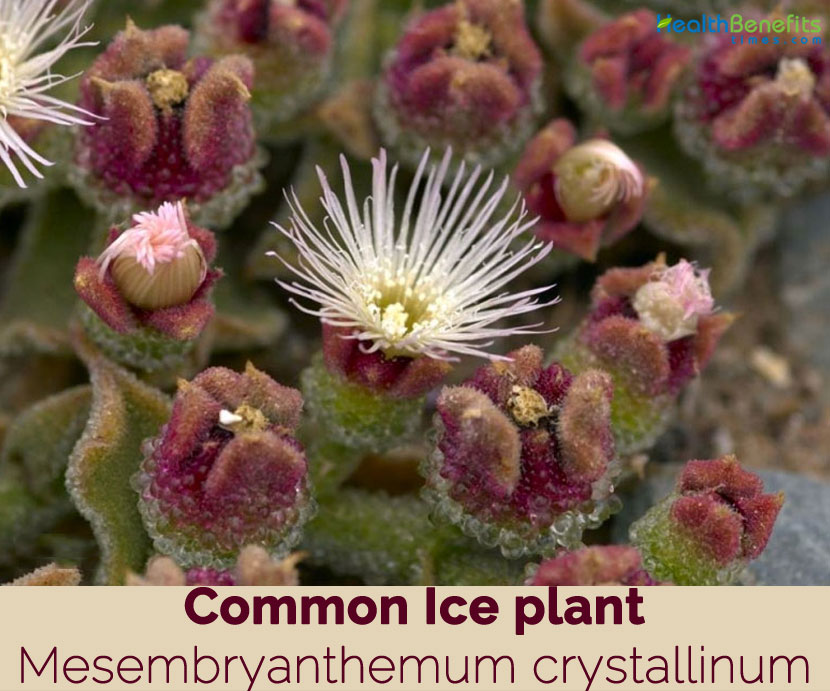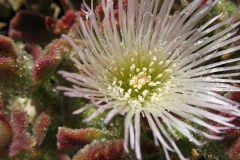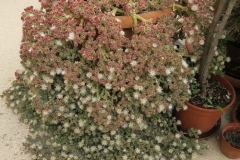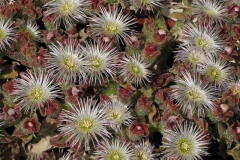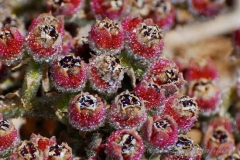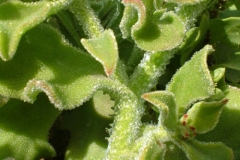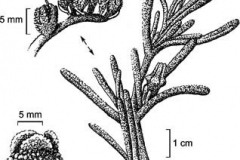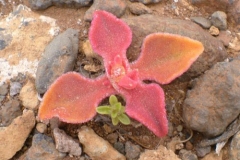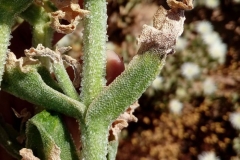Scientific name Mesembryanthemum was derived from the Greek word mesembria, which means ‘midday’ and anthemum, meaning ‘flower’, and came from a belief that the plants only flowered at midday. After some time, night-flowering species were discovered, and the name seemed inappropriate and was then changed so that it could indicate a flower with its fruit in the middle i.e. mesos, meaning ‘middle’, embryon, ‘embryo’ or ‘fruit’, and anthemom, ‘flower’. The species name crystallinum, means ‘with crystals’, which refers to the ice-like bubbles which are found on the leaves and stems. Common name ice plant is thought to be inspired by the glistening, ice-like bubbles on the leaves and stems, but is also reported to have arisen because it is claimed that even on the hottest day; the leaves are cool to the touch. The plant is covered with bladder cells, enlarged epidermal cells. The main function of these bladder cells is to reserve water. The plant is not to be confused with New Zealand spinach, which is occasionally referred to in gardening booklets as New Zealand ice plant.
Plant Description
Common Ice plant is a low growing, annual or biennial, robust succulent herb or dense prostrate shrub that usually grows about 1 meter tall. The plant can be annual, biennial or perennial, but its life cycle is usually completed within several months, depending on environmental conditions. The plant is found growing in maritime sands, salt marshes, roadsides, cliffs, over-grazed areas, and areas of coastal erosion, rubbish dumps and homestead yards. It also occurs in a range of vegetation communities, including saltmarsh; samphire flats, eucalypt woodlands and shrub lands. The plant can be found on wide range of soil types, from well-drained sandy soils (including sand dunes), to loams and clays. It prefers acid, neutral or alkaline soils, but can tolerate nutritionally poor or saline soils as well. Stems are trailing, diffusely procumbent, dichotomously branched up to 1 meter long, internodes terete 6 mm in diameter. The stems can range from green to red.
Leaves
The leaves are ovate to spathulate, forming a tear-drop-shape, with wavy margins, and die from the apex when they are older. Leaves are sessile or petiolate, opposite, or in the branches alternate, petiole, more or less stem clasping. Blade is ovate or spathulate, flat, acute or acuminate, basal leaves are largest; 2-20 cm long, and 3.5 cm broad, margin undulated. Bladder cells are very large, rounded to elongate. They are yellowish or grassy-green when new, but become rusty-orange with age.
Flower
Each flower appears singly and has numerous thin petals, 5 sepals, and many short stamens. The flowers are 30–50 mm across and the color of the flowers ranges from white to pink to mauve. The flower stalks are also succulent, with the crystals ranging from green to red, however, this varies from location to location. Flowers are hermaphrodite (have both male and female organs) and are pollinated by Insects. Flowering normally takes place from July to September. Flowers open in the morning and close at night.
Fruit
Fertile flowers are followed by broad-oblong capsules borne singly, containing many seeds per cell. They are about 6–11 mm long, 5–8 mm wide, perianth lobes sharply reflexed at maturity.
History
Though it was once grown in California, Australia, the Mediterranean as a decorative plant, it has become more commonly known as an invasive species and a threat to native vegetation. Ice plant was first introduced to California in the early 20th century when it was used to stabilize soil along railroad tracks. There are other forms of this plant which are popular in Asian regions that are also used in the same way, to help control erosion.
Health Benefits of Common Ice plant
Various regions around the world use common Ice Plant, as well as its cousin Kudzu, to treat different health conditions, including colds, fevers, and even glaucoma. Research has shown that this plant consists of extremely high levels of isoflavones as well as flavonoids and isoflavonoids which are plant metabolites that have a significant effect on human metabolism. The following are just a few of the many different medicinal uses of Common ice plant
1. Pulmonary Tuberculosis Control
Apart from relieving constipation, the juice of the common ice plant fruit is also known to be an effective solution for pulmonary tuberculosis, which is a transmissible bacterial infection of the lungs. Traditional healers usually add olive oil and honey to the said juice to make it more effective at dealing with pulmonary tuberculosis.
2. Improves Cardiovascular Health
Since there are compounds in ice plant that are very good at putting an end to inflammation, the herb is also used for promoting a healthier cardiovascular system. It is said that the use of common ice plant can help in keeping high blood pressure at bay as well as lowering the levels of bad cholesterol.
3. Relief from Minor Skin Problems
One of the most popular traditional uses of common ice plant is for the treatment of minor skin problems. Sap of common ice plant is the one that is particularly used for such. The sap of the herb may also be added to bathwater, which is suggested for soothing large areas of the body that are irritated.
4. UV Ray Protection
Did you know that there are a number of sunscreens with Common ice plant extract in them as it offers protection from harmful UV rays given off by the sun? What’s more, various ointments and creams for sunburn also consists of the said extract as it’s very effective in soothing achy and damaged skin caused by too much exposure to the sun.
5. Treatment of Constipation
Another very common medicinal use of common ice plant is for the relief of constipation. Fruit of the herb is the one that is used as it has laxative properties, and it is turned into juice. People who are prone to constipation may consume common ice plant fruit on a regular basis to encourage the evacuation of the bowels.
6. Relief Oral Problems
Chewing on the tip of a common ice plant leaf is a well-known cure for oral sores. Sometimes the juice of the leaves may be directly applied onto oral sores for a speedier healing process. Gargling with the said juice is also traditionally done for achieving relief from a sore throat and other infections pertaining to the oral cavity.
7. Skin Inflammation Control
Traditional healers also trust on common ice plant, in particular its sap, in dealing with various inflammatory conditions of the skin. Active biological compounds present in it are capable of controlling inflammation. As a matter of fact, some of the most effective topical solutions for psoriasis and other related skin conditions have common ice plant sap in them.
Traditional uses and benefits of Common Ice plant
- The plant is demulcent and diuretic.
- It is used in the treatment of inflammations of the pulmonary and genito-urinary mucous membranes.
- Leaves are used in the treatment of ascites, dysentery and diseases of the liver and kidney.
- It can be used externally to relieve itching, pain, swelling and redness of the skin.
- Leaves provide a safe trail side nibble, are sometimes pickled, and are demulcent to skin and mucous membranes, make a cooling and healing poultice for treating sunburn or minor lesions.
- Skin diseases such as neuro-dermatitis and psoriasis could be treated with Common Ice Plant sap.
- The leaf juice is astringent and mildly antiseptic.
- It is mixed with water and swallowed to treat diarrhea, dysentery and stomach cramps, and is used as a gargle to relieve laryngitis, sore throat and mouth infections.
- Leaves were formerly used as a treatment for scurvy for sailors on long voyages
Culinary Uses
- Leaves and stems can be consumed raw or cooked.
- They can be used as a spinach
- The leaves have an acid flavor; they are thick and very succulent with a slightly salty tang.
- They can also be pickled like cucumbers or used as a garnish.
- Seed is used as a famine food used when all else fails.
- The whole plant is consumed as a cereal.
References:
https://www.itis.gov/servlet/SingleRpt/SingleRpt?search_topic=TSN&search_value=503818#null
https://pfaf.org/user/Plant.aspx?LatinName=Mesembryanthemum+crystallinum
https://www.cabi.org/isc/datasheet/115578
http://www.floracatalana.net/mesembryanthemum-crystallinum-l-
https://plants.usda.gov/core/profile?symbol=MECR3
https://en.wikipedia.org/wiki/Mesembryanthemum_crystallinum
https://npgsweb.ars-grin.gov/gringlobal/taxonomydetail.aspx?id=24132
https://www.anbg.gov.au/cpbr/WfHC/Mesembryanthemum/index.html
https://www.cal-ipc.org/plants/profile/mesembryanthemum-crystallinum-profile/
https://bie.ala.org.au/species/http://id.biodiversity.org.au/node/apni/2889606#overview
https://davesgarden.com/guides/pf/go/57572/#b
https://wikivisually.com/wiki/Mesembryanthemum_crystallinum
http://www.theplantlist.org/tpl1.1/record/kew-2363096
http://www.llifle.com/Encyclopedia/SUCCULENTS/Family/Aizoaceae/32528/Mesembryanthemum_crystallinum
http://www.marz-kreations.com/WildPlants/AIZO/Mesembryanthemum_crystallinum.php
https://gd.eppo.int/taxon/MEKCR
http://tropical.theferns.info/viewtropical.php?id=Mesembryanthemum+crystallinum
http://www.cpbr.gov.au/cpbr/WfHC/Mesembryanthemum/index.html
Comments
| Common Ice plant Quick Facts | |
|---|---|
| Name: | Common Ice plant |
| Scientific Name: | Mesembryanthemum crystallinum |
| Origin | Northern Africa, south-western Africa, western Asia and southern Europe |
| Shapes | Broad-oblong capsules coarsely papillate, about 6–11 mm long, 5–8 mm wide |
| Taste | Salty, crisp |
| Health benefits | Controls Pulmonary Tuberculosis, Improves Cardiovascular Health, Treats Constipation, Relief Oral Problems, Relief from Minor Skin Problems, Controls Skin Inflammation, UV Ray Protection |
| Name | Common Ice plant |
|---|---|
| Scientific Name | Mesembryanthemum crystallinum |
| Native | Northern Africa (i.e. northern Algeria, northern Libya, Morocco, Tunisia and Egypt), south-western Africa (i.e. Namibia and South Africa), western Asia and southern Europe (i.e. Italy, south-western Yugoslavia, south-eastern France and Spain), and naturalized in North America, South America and Australia |
| Common Names | Common ice plant, common iceplant, crystalline ice plant, ice plant, ice-plant, fig marigold, frost plant, diamond plant, mid-day flowers, dew plant, Diamond ficoides, Edible iceplant, Glacier lettuce, fig |
| Name in Other Languages | Arabic: لوسغ (lusgh), Ghāsūl (غاسول), masnie althalj almushtarak (مصنع الثلج المشترك), aqbaru, taghassul Catalan: Herba cristallina, Herba de plata, Herba gelada, Herba cristal·lina Chinese: Shí yòng bīng yè (食用冰叶), Bīng yè rì zhōng huā (冰叶日中花) Croatian: Dubac vodeni Danish: Isplante Dutch: Ijskruid, Ijsplantje English: Common iceplant, Crystalline iceplant, Diamond ficoides, Edible iceplant, Glacier lettuce, Iceplant, Ice plant, Sea fig Finnish: Jääruoho, jääpäivikki French: Ficoïde à cristaux, Ficoïde cristalline, Ficoïde comestible, Ficoïde glaciale, Herbe à la glace, Mésembryanthème à cristaux German: Eisblume, Eiskraut, Eispflanze, Kristallkraut, Kristal-Mittagsblume, Kristall-Eiskraut, gemeines Eiskraut Greek: Pagokrýstallos fytikó̱n (Παγοκρύσταλλος φυτικών) Hebrew: Ahal haggevishim, אהל הגבישים Hungarian: Jeges kristályvirág Italian: Erba cristallina, Erba ghiacciola, erba cristallina comune Japanese: Aisupuranto (アイスプラント), Komon aisupuranto (コモン・アイスプラント) Korean: A i seu peul laen teu (아이스플랜트) Maltese: Kristallina tar-ramel, Kristallina kbira Norwegian: Ismiddagsblom Polish: Kristalowa połodnička Portuguese: Barrilha, Erva-de-gelo, Erva-do-orvalho, Erva-gelada, Flor-de-gelo, Folha-de-gelo, Planta-de-neve, Orvalho Russian: Khrustalʹnaia trava (Хрустальная трава), Ledianaia trava (Ледяная трава), Mezembriantemum khrustal’nyj (Мезембриантемум хрустальный) Spanish: Barrilla de Canarias, Escarchada, Escarchado, Escarchosa, Escarcha, Flor de la plata, Hierba de la plata, Hierba del rocío Hierba escarchada, Yerba de la plata, Yerba del rocío, Yerba escarcha, Yerba escarchada, Yerba plateada, Cabellera de la reina, Herba gelada Swedish: Isört |
| Plant Growth Habit | Low growing, annual or biennial, robust succulent herb or dense prostrate shrub |
| Growing Climates | Maritime sands, salt marshes, roadsides, cliffs, over-grazed areas, areas of coastal erosion, rubbish dumps and homestead yards. It also occurs in a range of vegetation communities, including saltmarsh, samphire flats eucalypt woodlands and shrub lands |
| Soil | Found on wide range of soil types, from well-drained sandy soils (including sand dunes), to loams and clays. It prefers acid, neutral or alkaline soils, but can tolerate nutritionally poor or saline soils |
| Plant Size | About 1 m tall |
| Stem | Trailing, diffusely procumbent, dichotomously branched up to 1 meter long, internodes terete c. 6 mm in diameter. The stems can range from green to red |
| Leaf | Sessile or petiolate, opposite, or in the branches alternate, petiole, more or less stem clasping, blade ovate or spathulate, flat, acute or acuminate, basal leaves largest, 2-20 cm long, and 3.5 cm broad, margin undulated |
| Flowering season | July to September |
| Inflorescence | Axillary or terminal, almost sessile. Basal bracts opposite, leaflike; upper bracts alternate, reduced |
| Flower | Hermaphrodite (have both male and female organs) and pollinated by Insects. White, suffused pink 7-30 mm in diameter. Calyx lobes 5, unequal. Tube round campanulate, terete, ageing red. Perianth segments 20-40, connate into tube, ovate, retuse and acute white, aging pink. |
| Fruit Shape & Size | Broad-oblong capsules coarsely papillate, about 6–11 mm long, 5–8 mm wide, perianth lobes sharply reflexed at maturity |
| Seed | About 200, brown, rough with minute tubercles |
| Propagation | By seed |
| Taste | Salty, crisp |
| Other Facts |
|
| Health Benefits |
|


